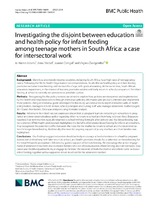| dc.identifier.citation | Hunter-Adams, J., Strebel, A., Corrigall, J., & Zweigenthal, V. (2022). Investigating the disjoint between education and health policy for infant feeding among teenage mothers in south africa: A case for intersectoral work. BMC Public Health, 22(1) doi:10.1186/s12889-021-12435-8 | en_US |
| dc.description.abstract | Background: Many low-and-middle-income countries, including South Africa, have high rates of teenage preg‑
nancy. Following the World Health Organisation recommendations, South African health policy on infant feeding
promotes exclusive breastfeeding until six months of age, with gradual weaning. At the same time, South Africa’s
education department, in the interest of learners, promotes adolescents’ early return to school post-partum. Yet infant
feeding at school is currently not perceived as a realistic option.
Methods: Recognising his this policy tension, we aimed to explore how policies are interpreted and implemented
by the health and education sectors through interviews with key informants who produce, interpret and implement
these policies. Using an interview guide developed for this study, we conducted in-depth interviews with 24 health
policy makers, managers in both sectors, school principals and nursing staf who manage adolescent mothers (aged
16-19) and their babies. Data was analysed using thematic analysis.
Results: Informants from both sectors expressed discomfort at pregnant learners remaining in school late in preg‑
nancy and were uncertain about policy regarding when to return to school and how long to breast-feed. Educators
reported that new mothers typically returned to school within a fortnight after delivery and that breastfeeding was
not common. While health professionals highlighted the benefts of extended breastfeeding for infants and mothers,
they recognised the potential confict between the need for the mother to return to school and the recommenda‑
tion for longer breastfeeding. Additionally, the need for ongoing support of young mothers and their families was
highlighted.
Conclusions: Our fndings suggest educators should actively encourage school attendance in a healthy pregnant
adolescent until delivery with later return to school, and health providers should focus attention on breastfeeding for
the initial 4-6weeks postpartum, followed by guided support of formula-feeding. We encourage the active engage‑
ment of adolescents’ mothers and extended families who are often involved in infant feeding and care decisions. Edu‑
cation and health departments must engage to facilitate the interests of both the mother and infant: some exclusive
infant feeding together with a supported return to school for the adolescent mother | en_US |

